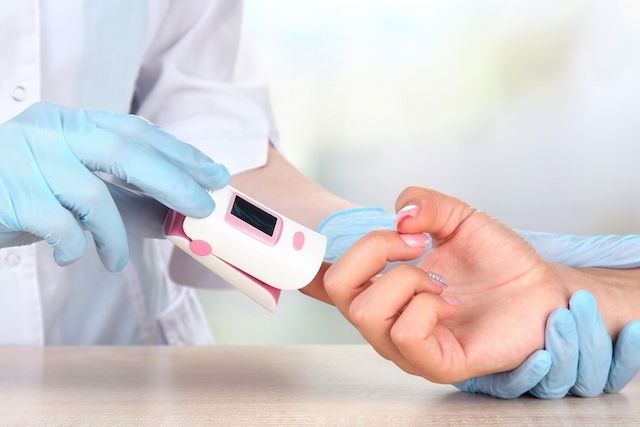Low oxygen levels means that the tissues will not receive the oxygen they need to function properly. This can occur due to abnormalities in the blood cells, lung diseases or circulation problems, for example.
A lack of oxygen in the blood, also known as hypoxemia, is a serious condition that can cause cell damage. It can be life-threatening if left untreated.
The brain can is one of the organs that can be most impacted by low blood oxygen levels, as brain cells can die in about 5 minutes from a lack of oxygen. Therefore, if you notice signs or symptoms of low blood oxygen levels, you should seek urgent medical attention.

Common symptoms
The main symptoms of low oxygen levels are:
- Shortness of breath
- Fast breathing
- Palpitations
- Irritability
- Dizziness
- Excessive sweating
- Mental confusion
- Drowsiness
- Fainting
- Cyanosis (when finger tips or lips start to turn blue or purple)
- Coma
To identify a lack of oxygen, the doctor will perform a physical exam and order texting, like pulse oximetry or blood gases testing. This will help determine the current concentration of oxygen circulating in the blood. Read about how you can increase your blood oxygen level.
How to measure oxygen
The fastest way to measure saturation levels is through a pulse oximeter, which is a small piece of equipment that is attached to a fingertip. It contains a light sensor that detects the amount of oxygen molecules circulating in the blood.
Generally, healthy people will have oxygen saturation levels over 95%. This value can dip to around 93% with a cold or flu, which is an expected finding and not of concern. However, when oxygen levels are noted to be less than 90%, it can be a sign of a serious illness. Learn more about how to measure your blood oxygen levels using pulse oximetry.
To know if your oxygen level is within range, enter your results below:
Another way to measure your blood oxygen level is through blood gases testing. This is done through a blood sample, which is analyzed in the lab. This test checks for oxygen levels as well as carbon dioxide and bicarbonate levels in the blood.
Main causes
Low oxygen levels can occur due to factors such as:
1. Altitude
Places with an altitude over 3000 m (or 1.8 mi) can increase your risk for decreased oxygen levels. The further away from sea level, the less the oxygen content in the air, making the air difficult to breathe.
This is also referred to as hypobaric hypoxia. It can cause several complications like acute pulmonary edema unrelated to the heart, cerebral edema, dehydration and hypothermia.
2. Lung disease
Changes in the lungs caused by illnesses like asthma, emphysema, pneumonia or acute pulmonary edema can make it difficult for oxygen to enter the lungs and enter its membranes. This can reduce overall oxygen levels in the body.
There are other types of situations that can also interfere with breathing, like neurologic disease or a coma. These conditions can impact how the lungs work.
3. Changes in blood composition
Anemia caused by a lack of iron or vitamins, bleeding or genetic disease can cause low oxygen levels in the body, even if your lungs are functioning properly.
This occurs because anemia is associated with a lower concentration of hemoglobin on the blood cells. Hemoglobin in responsible for the transport of oxygen to the rest of the body. Therefore, with lower hemoglobin levels, there is less oxygen transported. Learn more about hemoglobin and how high or low results can impact the way your body functions.
4. Poor circulation
This occurs when there is enough oxygen in the blood, however it is unable to reach tissues or organs in the body due to an obstruction (like a heart attack). It can also happen when blood flow is weak, like with heart failure.
5. Intoxication
Situation likes carbon monoxide, medication overdoses, alcohol and psychoactive substances can interfere with the adhesion of oxygen onto hemoglobin or impact the absorption of oxygen into the tissues. These can all lead to low blood oxygen levels.
6. Neonatal hypoxia
Neonatal hypoxia occurs due to a deficiency of oxygen absorption by the baby through the placenta, leading to fetal distress.
This can occur before, during or after the delivery and happens due to maternal, placental or fetal factors. It can lead to complications like cerebral palsy or intellectual disabilities.
7. Psychological factors
People with psychological disorders, like anxiety or chronic stress, use a higher amount of oxygen in times of distress. This can lead to the emergence of symptoms like shortness of breath, palpitations or confusion.
8. Climate
Some environmental conditions, like extreme heat or cold, will require higher amounts of oxygen to maintain metabolism and other normal bodily functions. This can increase your risk for hypoxia.
What to do
Treatment for low oxygen usually involves the use of an oxygen mask to stabilize oxygen levels. However, the situation will really only ever be treated once the underlying cause is addressed.
Depending on the cause, some treatments may involve the use of antibiotics (to treat pneumonia, for example), inhalers (for asthma), medications to improve lung and heart functioning, treatment for anemia or antidotes for poisoning.
In serious cases, where there is brain damage or if immediate treatment of the cause is not possible, artificial respiration and sedatives may be necessary in an intensive care unit. These interventions are required until the doctor is able to restore breathing capacity.






























